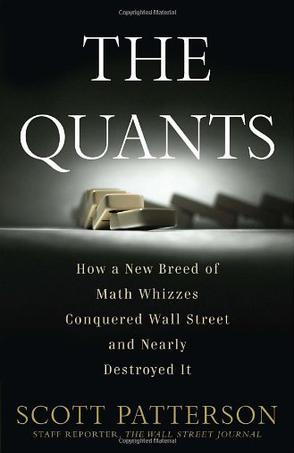-

The Quants
“Beware of geeks bearing formulas.” --Warren Buffett In March of 2006, the world’s richest men sipped champagne in an opulent New York hotel. They were preparing to compete in a poker tournament with million-dollar stakes, but those numbers meant nothing to them. They were accustomed to risking billions. At the card table that night was Peter Muller, an eccentric, whip-smart whiz kid who’d studied theoretical mathematics at Princeton and now managed a fabulously successful hedge fund called PDT…when he wasn’t playing his keyboard for morning commuters on the New York subway. With him was Ken Griffin, who as an undergraduate trading convertible bonds out of his Harvard dorm room had outsmarted the Wall Street pros and made money in one of the worst bear markets of all time. Now he was the tough-as-nails head of Citadel Investment Group, one of the most powerful money machines on earth. There too were Cliff Asness, the sharp-tongued, mercurial founder of the hedge fund AQR, a man as famous for his computer-smashing rages as for his brilliance, and Boaz Weinstein, chess life-master and king of the credit default swap, who while juggling $30 billion worth of positions for Deutsche Bank found time for frequent visits to Las Vegas with the famed MIT card-counting team. On that night in 2006, these four men and their cohorts were the new kings of Wall Street. Muller, Griffin, Asness, and Weinstein were among the best and brightest of a new breed, the quants . Over the prior twenty years, this species of math whiz --technocrats who make billions not with gut calls or fundamental analysis but with formulas and high-speed computers-- had usurped the testosterone-fueled, kill-or-be-killed risk-takers who’d long been the alpha males the world’s largest casino. The quants believed that a dizzying, indecipherable-to-mere-mortals cocktail of differential calculus, quantum physics, and advanced geometry held the key to reaping riches from the financial markets. And they helped create a digitized money-trading machine that could shift billions around the globe with the click of a mouse. Few realized that night, though, that in creating this unprecedented machine, men like Muller, Griffin, Asness and Weinstein had sowed the seeds for history’s greatest financial disaster. Drawing on unprecedented access to these four number-crunching titans, The Quants tells the inside story of what they thought and felt in the days and weeks when they helplessly watched much of their net worth vaporize – and wondered just how their mind-bending formulas and genius-level IQ’s had led them so wrong, so fast. Had their years of success been dumb luck, fool’s gold, a good run that could come to an end on any given day? What if The Truth they sought -- the secret of the markets -- wasn’t knowable? Worse, what if there wasn’t any Truth? In The Quants , Scott Patterson tells the story not just of these men, but of Jim Simons, the reclusive founder of the most successful hedge fund in history; Aaron Brown, the quant who used his math skills to humiliate Wall Street’s old guard at their trademark game of Liar’s Poker, and years later found himself with a front-row seat to the rapid emergence of mortgage-backed securities; and gadflies and dissenters such as Paul Wilmott, Nassim Taleb, and Benoit Mandelbrot. With the immediacy of today’s NASDAQ close and the timeless power of a Greek tragedy, The Quants is at once a masterpiece of explanatory journalism, a gripping tale of ambition and hubris…and an ominous warning about Wall Street’s future. -

Frequently Asked Questions in Quantitative Finance
"Getting agreement between finance theory and finance practice is important like never before. In the last decade the derivatives business has grown to a staggering size, such that the outstanding notional of all contracts is now many multiples of the underlying world economy. No longer are derivatives for helping people control and manage their financial risks from other business and industries, no, it seems that the people are toiling away in the fields to keep the derivatives market afloat (Apologies for the mixed metaphor ) If you work in derivatives, risk, development, trading, etc. you'd better know what you are doing, there's now a big responsibility on your shoulders. In this second edition of "Frequently Asked Questions in Quantitative Finance" I continue in my mission to pull quant finance up from the dumbed-down depths, and to drag it back down to earth from the super-sophisticated stratosphere. Readers of my work and blogs will know that I think both extremes are dangerous. Quant finance should inhabit the middle ground, the mathematics sweet spot, where the models are robust and understandable, and easy to mend. ...And that's what this book is about. This book contains important FAQs and answers that cover both theory and practice. There are sections on how to derive Black-Scholes (a dozen different ways ), the popular models, equations, formulas and probability distributions, critical essays, brainteasers, and the commonest quant mistakes. The quant mistakes section alone is worth trillions of dollars I hope you enjoy this book, and that it shows you how interesting this important subject can be. And I hope you'll join me and others in this industry on the discussion forum on wilmott.com. See you there " "FAQQF2."..including key models, important formulae, popular contracts, essays and opinions, a history of quantitative finance, sundry lists, the commonest mistakes in quant finance, brainteasers, plenty of straight-talking, the Modellers' Manifesto and lots more. Paul Wilmott has been called "the smartest of the quants, he may be the only smart quant" ("Portfolio" magazine/Nassim Nicholas Taleb), "cult derivatives lecturer" ("Financial Times"), "the finance industry's Mozart" ("Sunday Business"), "financial mathematics guru" (BBC) and "a very naughty boy" (his mother). -

金融随机分析(共2册)
《金融随机分析(共2卷)》是《金融随机分析》的第2卷,《金融随机分析》全书共分两卷。第一卷主要包括随机分析的基础性知识以及离散时问模型,利用较简单的离散时间二叉树模型给出了无套利期权定价方法;虽只用到简单的数学,但其中涉及的风险中性定价的概念卜分深刻。第二卷主要介绍连续时问模型及其在金融学中的应用;其中包含了较为实际的、具有很强操作性的定量经济学内容,同时也包含了较为完整的随机分析理论。全书各章均有评注和习题。 -

Financial Modeling
Too often, finance courses stop short of making a connection between textbook finance and the problems of real-world business. Financial Modeling bridges this gap between theory and practice by providing a nuts-and-bolts guide to solving common financial models with spreadsheets. Simon Benninga takes the reader step by step through each model, showing how it can be solved using Microsoft Excel. The long-awaited third edition of this standard text maintains the "cookbook" features and Excel dependence that have made the first and second editions so popular. It also offers significant new material, with new chapters covering such topics as bank valuation, the Black-Litterman approach to portfolio optimization, Monte Carlo methods and their applications to option pricing, and using array functions and formulas. Other chapters, including those on basic financial calculations, portfolio models, calculating the variance-covariance matrix, and generating random numbers, have been revised, with many offering substantially new and improved material. Other areas covered include financial statement modeling, leasing, standard portfolio problems, value at risk (VaR), real options, duration and immunization, and term structure modeling. Technical chapters treat such topics as data tables, matrices, the Gauss-Seidel method, and tips for using Excel. The last section of the text covers the Visual Basic for Applications (VBA) techniques needed for the book. The accompanying CD contains Excel worksheets and solutions to end-of-chapter exercises. -

Options, Futures and Other Derivatives (6th Edition)
Designed to bridge the gap between theory and practice, this successful book is regarded as "the bible" in trading rooms throughout the world. The books covers both derivatives markets and risk management, including credit risk and credit derivatives; forward, futures, and swaps; insurance, weather, and energy derivatives; and more. For options traders, options analysts, risk managers, swaps traders, financial engineers, and corporate treasurers. -

失灵
在华尔街做数量分析工作的物理学家通常被称为宽客,宽客建立模型的初衷是让华尔街能够避开风险、繁荣发展。但是在金融危机中,宽客们饱受指责,大家认为是宽客建立的复杂数学模型引发了金融危机。是什么让这些模型如此危险呢? 伊曼纽尔•德曼(Emanuel Derman)之前曾作为宽客在华尔街工作,他以业内人士的视角,犀利地分析了模型与人类认知之间的冲突。在个人生活甚至政治领域中,我们总能发现所谓的科学严谨并不那么令人信服。数学模型与物理模型关系极为密切,但是在物理领域,理论旨在描述事实,而在金融领域,模型只是尽可能地逼近事实。 德曼用金融理论和实践的亲身体验解释了看来可靠的模型为何会失效,为什么金融模型会使经济崩溃,并且提出了制定模型的一些基本原则,从而帮助人们逃脱模型所带来的束缚。